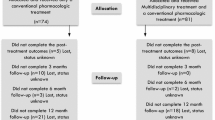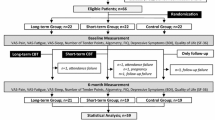Abstract
Fibromyalgia (FM) has a high impact on all aspects of health. The effect from interventions is usually small and characterized by uncertainty. Better insight in predictors for improved health is essential. The present study aimed to understand predictors for patient global impression of change and changes in overall health. Data from a longitudinal cohort of recently diagnosed FM patients (n = 203) were used. Within this cohort, patients were pre-randomized to either a multidisciplinary (n = 108) or an, aerobic exercise (n = 47) program, or usual care (n = 48). Only a limited number of patients started with the programs (n = 86) or participated fully, i.e., attended >70 % of the scheduled sessions (n = 68). Patients completed questionnaires covering all components of the International Classification of Functioning, Disability and Health (ICF) bio–psycho–social model of health, which was used as a framework to structure potential predictors. Principal component analysis was used to reduce the number of potential predictors. Regression analyses were used to explore associations with the outcome variables. Principal component analysis yielded five factors representing areas that covered different ICF components and chapters. “Being employed” and “full participation in a program” were independently associated with a better global impression of change. A longer duration of FM-related symptoms and more limitations in physical areas of body functions were independently associated with a worse impression of overall health. Higher levels of perceived limitations in physical and mental activities were associated with “starting to participate in a program” and with “full participation in a program.” Recently diagnosed FM patients that report fewer physical limitations may experience more improvement in health if they are at work and have a positive attitude towards participating in an offered health-care intervention. These findings give support to an active rather than to a care-avoiding attitude of health-care workers in their contacts to these patients.


Similar content being viewed by others
References
Wagner EH (1998) Chronic disease management: what will it take to improve care for chronic illness? Effect Clin Pract 1(1):2–4
Mease P (2005) Fibromyalgia syndrome: review of clinical presentation, pathogenesis, outcome measures, and treatment. J Rheumatol 75:6–21
Carville SF, Arendt-Nielsen S, Bliddal H, Blotman F, Branco JC, Buskila D et al (2008) EULAR evidence-based recommendations for the management of fibromyalgia syndrome. Ann Rheum Dis 67(4):536–541
Hauser W, Arnold B, Eich W, Felde E, Flugge C, Henningsen P et al (2008) Management of fibromyalgia syndrome—an interdisciplinary evidence-based guideline. Ger Med Sci 6:Doc14
Hauser W, Bernardy K, Arnold B, Offenbacher M, Schiltenwolf M (2009) Efficacy of multicomponent treatment in fibromyalgia syndrome: a meta-analysis of randomized controlled clinical trials. Arthritis Rheum 15;61(2):216–24
Karjalainen K, Malmivaara A, van Tulder M, Roine R, Jauhiainen M, Hurri H, et al. (2000) Multidisciplinary rehabilitation for fibromyalgia and musculoskeletal pain in working age adults. Cochrane database of systematic reviews Online Update Software ISE: 1469 493X. (2):Cd001984
Bodenheimer T, Wagner EH, Grumbach K (2002) Improving primary care for patients with chronic illness: the chronic care model, Part 2. JAMA 288(15):1909–1914
Wagner EH, Austin BT, Von Korff M (1996) Improving outcomes in chronic illness. Manag Care Q 4(2):12–25
Reisine S, Fifield J, Walsh S, Forrest DD (2008) Employment and health status changes among women with fibromyalgia: a five-year study. Arthritis Rheum. 15;59(12):1735–41
Linares M, Pérez I, Pérez M, Labry-Lima A, Hernandez-Torres E, P-c J (2008) Analysis of the impact of fibromyalgia on quality of life: associated factors. Clin Rheumatol 27:613–619
Dobkin P, De Civita M, Abrahamowicz M, Baron M, Bernatsky S (2006) Predictors of health status in women with fibromyalgia: a prospective study. Int J Behav Med 13(2):101–108
Oliver K, Cronan T (2003) Predictors of exercise behaviors among fibromyalgia patients. Prev Med 35:383–389
Nicassio P, Schoenfeld-Smith K, Radojevic V, Schurman C (1995) Pain coping mechanisms in fibromyalgia: relationship to pain and functional outcomes. J Rheumatol 22(8):1552–1558
Prior K, Bond M (2004) The roles of self-efficacy and abnormal illness behaviour in osteoarthritis self-management. Psych Health&Med 2(2):177–192
Hasenbring MI, Plaas H, Fischbein B, Willburger R (2006) The relationship between activity and pain in patients 6 months after lumbar disc surgery: do pain-related coping modes act as moderator variables? Eur J Pain 10(8):701–709
Vlaeyen JW, Kole Snijders AM, Boeren RG, van Eek H (1995) Fear of movement/(re)injury in chronic low back pain and its relation to behavioral performance. Pain 62(3):363–372
Karsdorp P, Vlaeyen J (2009) Active avoidance but not active pacing is associated with disability in fibromyalgia. Pain 147:29–35
Mease P, Arnold LM, Choy EH, Clauw DJ, Crofford LJ, Glass JM et al (2009) Fibromyalgia syndrome module at OMERACT 9: domain construct. J Rheumatol 36(10):2318–2329
Mease PJ, Arnold LM, Bennett R, Boonen A, Buskila D, Carville S et al (2007) Fibromyalgia syndrome: OMERACT 7 workshop2. J Rheumatol 34(6):1415–1425
Mease PJ, Clauw DJ, Arnold LM, Goldenberg DL, Witter J, Williams DA, et al. (2--5) Fibromyalgia syndrome: OMERACT 7 workshop 1. J Rheumatol 32(11):2270–7
Picavet HS, Hoeymans N (2004) Health related quality of life in multiple musculoskeletal diseases: SF-36 and EQ-5D in the DMC3 study. Ann Rheum Dis 63(6):723–729
Verbunt JA, Pernot DH, Smeets RJ (2008) Disability and quality of life in patients with fibromyalgia. Health Qual Life Outcomes 6:8
Prodinger B, Cieza A, Williams DA, Mease P, Boonen A, Kerschan-Schindl K, et al.(2008) Measuring health in patients with fibromyalgia: content comparison of questionnaires based on the International Classification of Functioning, Disability and Health. Arthritis Rheum 15;59(5):650–8
WHO (2001) International classification of functioning, disability and health: ICF. World Health Organization, Geneva
American, College, Sports, Medicine. Position Stand (1998) The recommended quantity and quality of exercise for developing and maintaining cardiorespiratory and muscular fitness, and flexibility in healthy adults. Med Sci Sports Exerc 30(975–991)
van Eijk-Hustings Y, Kroese M, Tan F, Boonen A, Bessems-Beks M, Landewé R (2013) Challenges in demonstrating the effectiveness of multidisciplinary treatment on quality of life, participation and health care utilisation in patients with fibromyalgia. A randomised controlled trial. Clin Rheumatol 32(2):199–209. doi:10.1007/s10067-012-2100-7
The EuroQol Group (1990) EuroQol-a new facility for the measurement of health-related quality of life. Health Policy 16(3):199–208
Dolan P (1997) Modeling valuations for EuroQol health states. Med Care 35(11):1095–1108
Bennett R (2005) The Fibromyalgia Impact Questionnaire (FIQ): a review of its development, current version, operating characteristics and uses. Clin Exp Rheumatol 23(5 Suppl 39):S154–S162
Schwarzer R, & Jerusalem M (1995) Generalized Self-efficacy scale. In J. Weinman, S.Wright & M. Johnston, Measures in health psychology: a user's portfolio. Causal and control beliefs (pp.35-37) Windsor, UK: NFER-NELSON
Vercoulen JHHM, Alberts M, Bleijenberg G (1999) De Checklist Individual Strength (CIS). Gedragstherapie 32:131–136
Sullivan MJL, Bishop SR, Pivik J (1995) The pain catastrophizing scale: development and validation. Psych Assess 7:524–432
Watson D, Clark LA, Tellegen A (1988) Development and validation of brief measures of positive and negative affect: the PANAS scales. J Pers Soc Psychol 54(6):1063–1070
McCracken LM, Zayfert C, Gross RT (1992) The pain anxiety symptoms scale: development and validation of a scale to measure fear of pain. Pain 50(1):67–73
Geyh S, Müller R, Peter C, Bickenbach JE, Post MWM, Stucki G, et al. (2011) Capturing the psychologic-personal perspective in spinal cord injury. Am J Phys Med Rehabil 90(11 Suppl 2):S79-965):doi: 10.1097/PHM.0b013e318230fb68
Cieza A, Stucki G (2005) Content comparison of health-related quality of life (HRQOL) instruments based on the international classification of functioning, disability and health (ICF). Qual Life Res 14(5):1225–1237
Liedberg GM, Henriksson CM (2002) Factors of importance for work disability in women with fibromyalgia: an interview study. Arthritis Rheum. 15;47(3):266–74
Weigl M, Cieza A, Cantista P, Reinhardt J, Stucki G (2008) Determinants of disability in chronic musculoskeletal health conditions: a literature review. Eur J Phys Rehabil Med 44:67–79
Anga D, Kalethb A, Bigattic S, Mazzucaa S, Sahad C, Hilligossa J et al (2011) Research to encourage exercise for fibromyalgia (REEF): use of motivational interviewing design and method. Contemp Clin Trials 32(1):59–68
Busch A, Schachter CL, Peloso PM, Bombardier C (2002) Exercise for treating fibromyalgia syndrome. Cochrane database of systematic reviews Online Update Software (3):Cd003786
Funding
The study was supported by Maastricht University Medical Centre and by Care Renewal Grants of medical insurance companies in the region.
Disclosures
None.
Author information
Authors and Affiliations
Corresponding author
Rights and permissions
About this article
Cite this article
van Eijk-Hustings, Y., Kroese, M., Boonen, A. et al. Predictors for health improvement in patients with fibromyalgia: a 2-year follow-up study. Clin Rheumatol 34, 133–141 (2015). https://doi.org/10.1007/s10067-013-2371-7
Received:
Revised:
Accepted:
Published:
Issue Date:
DOI: https://doi.org/10.1007/s10067-013-2371-7




